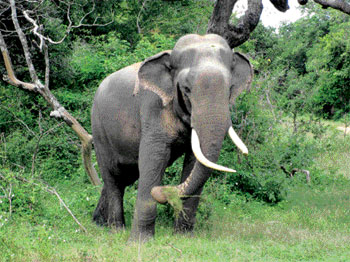Economic development should blend with nature -Dr. Sumith
Pilapitiya
by Gamini WARUSHAMANA
Sri Lanka has developed the right policies to protect bio diversity
but their implementation is not taking place properly, said
environmentalist Dr. Sumith Pilapitiya. He was delivering the keynote
speech at a seminar on Sustainable Bio Diversity and Economic
Development organised by the Ceylon Chamber of Commerce in Colombo last
week.
|

The Asian elephant is Sri Lanka’s flagship species |
Dr. Pilapitiya said thatsome environment issues created by major
development projects such as the Mattala Air port, reports on plans to
relocate elephants from the Commonwealth Games site in Hambantota,
construction of a road across the Wilpattu national park and
construction of hotels in protected areas demonstrate this inconsistency
of policies and practice.
The Department of Wild Life Conservation and the Department of
Forestry are under two different ministries. In the Mahinda Chintana
policy statement it was clearly stated that they should be under one
ministry. This has created issues in implementing environment policies.
He also said that the private sector too has a responsibility to
invest in conservation of bio diversity, especially if government
investment is not sufficient. Industries such as hotels that are selling
nature have a greater responsibility in this regard, he said.
The following are excerpts from his speech on Sustainable Bio
diversity and its Economic Value.
Global scenario
The earth's bio diversity is under severe threat and extinction rates
of species over the past hundred years have been several hundred times.
If the situation continues, future extinction rates will be ten times
higher.
Since 1980 global forest cover has declined by about 225 million ha
and a size similar to that of Bangladesh is being lost annually.
Loss of bio diversity is a crisis that threatens human beings. The
earth's bio diversity is crucial to human well-being because it has
important functions. It provides us commodities such as food, fresh
water and fuel, and carries out regulating functions such as climate and
disease regulation and water purification. It has cultural functions
aesthetic, spiritual, educational and recreational.
|

Dr. Sumith Pilapitiya |
The estimated value of these ecosystem services is around $ 33
trillion/year, which is twice the global GNP. The cost of loss of bio
diversity is massive. Loss of topsoil due to deforestation can reduce
rice output by 1.5 million tons a year, an amount that would feed up to
15 million people an year.
Tropical forest loss is currently responsible for about 1/5th of all
human carbon emissions which leads to global warming. If not lost, it
could absorb emissions from the entire global transportation sector.
This destruction continues under the name of economic development.
There is a perception that environmentalists are anti-development
oriented. This is not true and environmentalists are more
pro-development than most others because they strive for development
that is sustainable.
Sustainable development looks beyond the private costs and benefits
of the immediate user of the natural resource and looks at social costs
and benefits to society as a whole.
Sri Lankan scenario
The world's first nature sanctuary was in ancient Sri Lanka headed by
king Devanampiyatissa. Development in ancient Sri Lanka was based on an
environmental impact assessment. Our forefathers lived in the Dry Zone
and they did not encroach the wet zone. They protected watersheds
because they realised their value. The Wet Zone opened during
colonialisation.
More recently, constitutional guarantees and national policies on
environmental conservation were adopted. Sri Lanka is a signatory to the
Convention on Biological Diversity. Sri Lanka is the first country in
Asia that prepared a National Environmental Action Plan in 1992. The
Mahinda Chintana economic policy of the government clearly states the
need of development in harmony with nature.
However, in practice unsustainable development programs can be seen
everywhere. Prawn farms in the North Western coast is a classic example.
Environmentalists warned that if the industry grew at an unsustainable
scale it would collapse. The industry is now ruined. Filling of wetlands
in metropolitan Colombo is another example where policy makers did not
listen to environmental concerns.
During the rainy season half of Colombo city is under water and
billions of rupees have to be spent to arrest the situation. Land
alienation for sugarcane cultivationin the Moneragala district has
caused human-elephant conflict.
This does not mean that we should not necessarily have implemented
such development projects. But land use should be better planned and
development options should be compatible with the natural resource base.
As the government has already accepted, the only Millenium Development
Goal (MDG) Sri Lanka is not on track to meet is MDG 7 ensuring
environmental sustainability.
Natural resource based development
Sri Lanka has the highest bio diversity per unit area in Asia and is
a global bio diversity hot spot. Bio diversity, ecosystems and ecosystem
services of a country represent a capital asset. Value of watersheds in
Sri Lanka is over $40 million/year. However, we have not considered
these when making development plans.
Protected Areas (PAs)
Extensive human activity in the peripheries of the PA network
(including the buffer zones) are threatening long-term survival of the
PA network and the bio diversity it contains. Expansion of the PA
network may not be possible. The latest advances in conservation looks
at a landscape approach to preserve tropical forests and bio diversity.
The PA is situated within the larger landscape so that PAs can meet
both conservation goals and human needs. The conservation landscape
outside PAs are developed with activities compatible with management of
the ecosystem.
Development is not only achieved through mega/large scale
infrastructure projects. A community's development, a significant
improvement in their quality of life is another aspect of development.
Development that is incompatible with the surrounding ecosystem is
unsustainable. Sri Lanka's development should aim for conservation
landscapes based on natural resources.
Conservation tourism
Sri Lanka is the best location for charismatic species outside
Africa. Yala and Wilpattu are the best places in the world to see
leopards; Minneriya, Kaudulla and Uda Walawe to view large herds of
Asian Elephants; Mirissa, Kalpitiya and Trinco for blue and sperm
whales.
Sri Lanka is the only place in the world where one can see the
largest sea mammal (the whale) in the morning and see the largest land
mammal (the elephant) in the same afternoon.
Development and bio diversity conservation go hand in hand to ensure
sustainable economic development. Although the government's commitment
to promote conservation tourism is commendable it has not taken the
right path.
The focus of Sri Lanka Tourism is on the number of visitors and not
on the quality of the experience. The government will promote
construction of hotels in buffer zones of PAs and additional bungalows
within the National Parks.
These policies are contrary to sustainable conservation tourism.
These are not what the conservation tourists want. A survey conducted by
interviewing international visitors to PAs (Yala, Uda Walawe, Minneriya,
Bundala and Sinharaja) confirm that high satisfaction with the wildlife
experience and dissatisfaction with the poor quality of guides, over
crowding of parks and traffic congestion in the parks.
Conservation tourists are willing to pay 60 percent more as entrance
fees if the quality of the experience improves. We should aim for high
value added, low impact tourism.
Surveys show that currently "non-package" tourists visiting National
Parks spend more than double compared with the regular "package
tourists".
Accommodation facilities should be low impact and tented safari
camping and eco-friendly resorts in forests should be outside the buffer
zones. The number of tourists entering these sensitive ecosystems should
always remain below capacity.
Landscapes surrounding PAs are a part of an ecologically sensitive
ecosystem. Therefore, development projects in such areas should be
sensitive to the ecosystem and be within its carrying capacity. Extra
investment in "greening" infrastructure in sensitive ecosystems is
needed (such as smart green infrastructure in tiger conservation
landscapes). Identification of land for development should take the
land's ecosystem service value into consideration.
Landscapes with elephants
According to studies 2/3 of the elephants are outside the PA network.
Thestrategy of "driving" and "translocating" elephants from development
areas into PAs have been tried for over 50 years and has failed. If not
the human-elephant conflict should be under control by now.
Erecting electric fences on the administrative boundaries of the
Department of Wildlife Conservation (DWC) has served only as boundary
markers for DWC as they have not been boundaries for elephants.
Sri Lanka does not have a strategy for elephant conservation and only
respond to Human-Elephant Conflicts (HEC) on an ad-hoc basis, largely
driven by political demands.
A paradigm shift needed
The Asian Elephant is Sri Lanka's flagship species. Elephant
conservation is important from an ecological perspective because they
are considered an 'umbrella species'. Their conservation protects a
large number of other species occupying the same area. Elephant viewing
is also an economic asset. In the management of HEC the elephant's needs
should also be taken into account and not only the human's needs.
Developer's responsibilities
Development projects in elephant landscapes should not only 'ring
fence' their projects from elephants. These development projects result
in driving elephants into conflict with humans due to a reduction in the
elephant range. Development costs should include mitigation measures for
affected communities. This should be a part of the project development
costs in elephant landscapes.
The government's responsibility is to ensure the project developer
(be it public or private) is responsible for HEC mitigation arising as a
result of the project.
A National Policy on Wild Elephant Conservation has been developed
and approved by the Cabinet in 2006. Strong coordination is vital
between DWC and the Forestry Department to implement it. |

